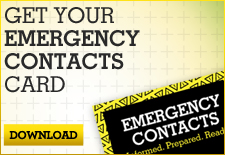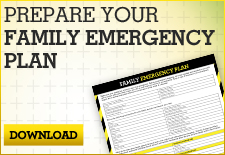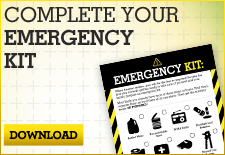
Disasters can happen… at any time. Be prepared to take action before, during and after.
Winter Storms
The National Weather Service refers to winter storms as the “Deceptive Killers” because most deaths are indirectly related to the storm. People are injured or killed in traffic accidents on icy roads, or suffer from hypothermia due to prolonged exposure to the cold. Winter storms can knock out heat, power and communications, sometimes for days at a time.
Winter storms include a variety of weather, including snow or subfreezing temperatures, strong winds and even ice or heavy rain storms. Detailed information on winter storms can be found by contacting the National Weather Service Forecast Office, your local emergency management agency, or by monitoring local TV, radio, and NOAA weather radio.
There are different terms used to refer to winter storms:
Before
Before winter approaches, add supplies to your emergency kit to prepare for the weather. This may include rock salt to melt ice on walkways, sand to improve traction, snow shovels and other snow removal equipment. Make sure you have adequate clothing and blankets to keep you and your family warm. Consider purchasing a generator to use in the event of prolonged power outages.
2 – Complete the Emergency Contacts Card and place one in your Emergency Kit.
3 – Prepare an Emergency Kit. The Emergency Kit should be easily accessible should you and your family be forced to shelter in place (stay at home) for a period of time.
- Have your heating system checked by a professional annually. This will ensure that your system is working safely and efficiently which, in turn, will save you money.
- If you heat by wood, clean your fireplace or stove. Have your chimney flue checked for any buildup of creosote and then cleaned to lessen the risk of fire.
- Make sure your home is well insulated and that you have weather stripping around your doors and windowsills to keep the warm air inside.
- Close off unneeded rooms, stuff towels or rags in the cracks under doors and cover windows at night.
- Use extreme caution when using alternative heating sources. Refuel kerosene heaters outside and keep them at least three feet from flammable objects. When using kerosene heaters, be sure to maintain ventilation to avoid build‐up of toxic fumes.
- To keep pipes from freezing wrap pipes in insulation, heat tape or layers of old newspapers. Cover the newspapers with plastic to keep out moisture and let faucets drip a little to avoid freezing.
- Learn how to shut off water valves in case a pipe bursts. If the pipes freeze, remove any insulation or layers of newspapers and wrap pipes in rags.
- Disconnect garden hoses and shut off and drain water from pipes leading to outside faucets. This reduces the chance of freezing in the short span of pipe just inside the house.
- Plan ahead for winter travel. Be sure to let someone know where you are going, along with your primary and alternate routes.
- Prepare your vehicle for winter by checking, or having your mechanic check your car. This includes antifreeze levels, battery and ignition systems, breaks, exhaust systems, fuel and air filters, lights, oil, and windshield wipers and fluid.
During severe winter weather, stay indoors to the greatest extent possible. If you have to leave your house, plan ahead and make sure you have emergency supplies in your car, including warm clothing in case your car is stuck.
- Wear layers of loose‐fitting, lightweight, warm clothing. Several layers of lightweight clothing will keep you warmer than a single heavy coat. Wear gloves (or mittens) and a hat to help prevent loss of body heat.
- Stay indoors during storms.
- Check on elderly relatives or neighbors who may need additional assistance to ensure their safety.
- Walk carefully on snowy, icy, walkways.
- Use caution not to over exert yourself when shoveling snow.
- Cover your mouth with a scarf to protect your lungs from extremely cold air.
- Keep dry. If possible, change wet clothing frequently to prevent a loss of body heat.
- Avoid driving during winter storms. If you must drive, stay on main roads and avoid back road shortcuts. Try to travel only during the day.
- If you will be going away during cold weather, leave the heat on in your home, set to a temperature no lower than 55ºF.
- Conserve fuel, if necessary, by keeping your residence cooler than normal. Temporarily close off heat to some rooms.
- Plan ahead for winter travel. Be sure to let someone know where you are going, along with your primary and alternate routes.
- If you get trapped in your car during a blizzard, pull off the highway. Turn on hazard lights and hang a distress flag from your antenna or window.
- Remain in your vehicle where rescuers are most likely to find you. Do not set out on foot during a blizzard unless you can see a building close by where you know you can take shelter. If you do leave the vehicle, use extra caution because distances are distorted by blowing snow.
- Run the engine and heater about 10 minutes each hour to keep warm. When the engine is running, open a downwind window slightly for ventilation and periodically clear snow from the exhaust pipe to guard against possible carbon monoxide poisoning.
- Huddle with other passengers and use your coat for a blanket.
- Take turns sleeping. One person should be awake at all times to look for rescue crews.
- Drink fluids to avoid dehydration.
- Be careful not to waste battery power. Balance electrical energy needs (use of lights, heat, radio) with supply.
- If stranded in a remote area, stomp large block letters in an open area spelling out HELP or SOS and line with rocks or tree limbs to attract the attention of rescue personnel who may be surveying the area by airplane.
After the danger from a winter storm passes, or when roads are cleared, seek out additional ways to stay warm. This may include going to a shelter or warming center if your home is not warm. Avoid walking outside on slippery or hilly surfaces until ice has melted. Use caution, as snow and ice can melt during the day and re‐freeze as temperatures drop in the evening.
- Go to a designated public shelter if your home loses power or heat during periods of extreme cold. Text SHELTER + your ZIP code to 43362 (4FEMA) to find the nearest shelter in your area or contact your local American Red Cross Chapter or Emergency Management Agency.
- Continue to protect yourself from frostbite and hypothermia by wearing warm, loose‐fitting, lightweight clothing in several layers. Stay indoors, if possible.
- If you’ve lost power, use battery‐powered flashlights rather than candles or other open flames for light. Many injuries and deaths result from accidental fires caused by candles during winter storms.



